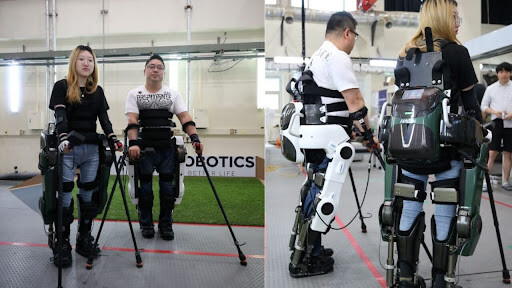
[GLOBAL ECONOMIC TIMES] When Kim Seung-hwan, a researcher at the Korea Advanced Institute of Science and Technology (KAIST), who is completely paralyzed from the waist down and is sitting in a wheelchair, presses a button, a robot leg strides forward in front of him. When Researcher Kim inserted both feet into the robot, the robot bent its knees and made a “click” sound and was placed on Researcher Kim’s legs by itself. Afterwards, the robot leg raised Researcher Kim's body and began to walk forward with the sound of "start."
This robot, which moves on its own like the suit worn by the movie protagonist Iron Man, is the new wearable robot 'WalkON Suit F1' developed by Professor Gong Gyeong-cheol's research team in the Department of Mechanical Engineering at KAIST. The research team unveiled the walk-on suit F1 for the first time at the Angel Robotics Advanced Research Institute in Daejeon on the morning of the 24th. According to the research team, this is the first case of fully implementing wearable technology that disabled people can wear on their own. It overcomes the limitations of existing rehabilitation robots, which could only be worn with the assistance of another person.
Researcher Kim played a major role in perfecting the new technology. He, who was completely paralyzed from the waist down in an accident, has been working on the hardware development of the walk-on suit F1 since January 2023. Based on his feedback, the research team implemented the hardware needed for actual users, including how to wear it and how to fix it after wearing it. Researcher Kim said, "When I first put on the robot, I couldn't even think of how to walk, but after trying a few steps, I felt like I was walking due to vibrations in my upper body. Being able to stand stably while moving both hands freely is like a dream."
The research team put a lot of effort into implementing technology that allows robots to balance themselves. This is to prevent accidents where the robot falls during the wearing process and to allow users to walk without a cane even after wearing the robot. The Walk-on Suit F1 can reach a speed of about 3.2 km per hour, similar to the walking speed of an average person. Park Jeong-soo, a researcher at KAIST, said, “For people with disabilities, the most difficult part of actually wearing it is the step of standing up from a standstill and starting to walk, and balance is important to accomplish this process stably.” In fact, during the demonstration that day, Researcher Kim easily performed tasks that required a high level of balance, such as picking up objects that had fallen on the ground or eating food.
The reason the Walk-on Suit F1 can move without losing balance is thanks to the 6-channel ground reaction force sensor attached to the foot. If the balance is broken through the sensor, the robot tilts itself to maintain a stable posture. In addition, the vision recognition and neural network implemented artificial intelligence (AI) control board attached to the robot recognizes the surrounding situation and maintains balance. Another feature is that it can walk sideways thanks to the 12-degree-of-freedom robot legs equipped with domestic high-output torque motors. Existing rehabilitation robots had to manually change the direction of their legs to walk sideways. Degree of freedom is an indicator of how freely a robot can move, and humanoid robot legs generally have about 6 degrees of freedom.
What breathes life into the Walk-on-Suit F1 hardware is AI learning. In the beginning, reinforcement learning was conducted to prevent walking or falling in a physical space implemented through computer simulation. Up to this point, it is similar to humanoid learning, but the Walk-on Suit F1 later evolved into a customized robot by learning the user's movements while actually being used by a disabled person. As Researcher Kim practiced wearing the robot over the past three months, the robot's movements also became smoother.
The research team plans to participate in the 3rd Cybathlon held on the 27th of this month and demonstrate walk-on suit F1 technology. Cybathlon is a competition to develop assistive robots for the disabled, in which disabled people wear wearable robots and compete in races such as walking or climbing stairs. Professor Gong said, “Wearable robots are physical assistance devices for the disabled and the elderly, and at the same time, they are devices that can secure a lot of data from the body.” He added, “In the future, they will also play an important role as an intermediary in developing the movements of various robots, including humanoids.”
[Copyright (c) Global Economic Times. All Rights Reserved.]



























